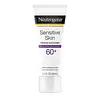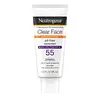What's inside
What's inside
 Key Ingredients
Key Ingredients

 Benefits
Benefits

 Concerns
Concerns

 Ingredients Side-by-side
Ingredients Side-by-side

Titanium Dioxide 4.9%
Cosmetic ColorantZinc Oxide 4.7%
Cosmetic ColorantWater
Skin ConditioningButyloctyl Salicylate
Skin ConditioningBeeswax
Emulsion StabilisingStyrene/Acrylates Copolymer
Silica
AbrasiveButylene Glycol
HumectantPEG-8
HumectantGlyceryl Stearate
EmollientPEG-100 Stearate
Cetyl Dimethicone
EmollientBenzyl Alcohol
PerfumingDimethicone
EmollientMethicone
EmollientArachidyl Alcohol
EmollientPolyhydroxystearic Acid
EmulsifyingHydroxyethyl Acrylate/Sodium Acryloyldimethyl Taurate Copolymer
Emulsion StabilisingPEG-8 Laurate
EmulsifyingXanthan Gum
EmulsifyingIsohexadecane
EmollientBehenyl Alcohol
EmollientTrisiloxane
Skin ConditioningEthylhexylglycerin
Skin ConditioningDisodium EDTA
Trimethylsiloxysilicate
EmollientArachidyl Glucoside
EmulsifyingBisabolol
MaskingDipotassium Glycyrrhizate
HumectantTriethoxycaprylylsilane
BHT
AntioxidantPolysorbate 60
EmulsifyingStearic Acid
CleansingMethylisothiazolinone
PreservativePolyaminopropyl Biguanide
PreservativePolymethyl Methacrylate
Tocopheryl Acetate
AntioxidantAscorbic Acid
AntioxidantPantothenic Acid
Skin ConditioningRetinyl Palmitate
Skin ConditioningAlumina
AbrasiveTitanium Dioxide 4.9%, Zinc Oxide 4.7%, Water, Butyloctyl Salicylate, Beeswax, Styrene/Acrylates Copolymer, Silica, Butylene Glycol, PEG-8, Glyceryl Stearate, PEG-100 Stearate, Cetyl Dimethicone, Benzyl Alcohol, Dimethicone, Methicone, Arachidyl Alcohol, Polyhydroxystearic Acid, Hydroxyethyl Acrylate/Sodium Acryloyldimethyl Taurate Copolymer, PEG-8 Laurate, Xanthan Gum, Isohexadecane, Behenyl Alcohol, Trisiloxane, Ethylhexylglycerin, Disodium EDTA, Trimethylsiloxysilicate, Arachidyl Glucoside, Bisabolol, Dipotassium Glycyrrhizate, Triethoxycaprylylsilane, BHT, Polysorbate 60, Stearic Acid, Methylisothiazolinone, Polyaminopropyl Biguanide, Polymethyl Methacrylate, Tocopheryl Acetate, Ascorbic Acid, Pantothenic Acid, Retinyl Palmitate, Alumina
Butyl Methoxydibenzoylmethane 2.7%
UV AbsorberHomosalate 4%
Skin ConditioningEthylhexyl Salicylate 4.5%
UV AbsorberOctocrylene 6%
UV AbsorberBenzophenone-3 4.5%
UV AbsorberWater
Skin ConditioningSilica
AbrasiveCetyl Dimethicone
EmollientStyrene/Acrylates Copolymer
C12-15 Alkyl Benzoate
AntimicrobialSteareth-100
Gel FormingEthylhexylglycerin
Skin ConditioningPhenoxyethanol
PreservativeCaprylyl Glycol
EmollientSodium Polyacrylate
AbsorbentDimethicone
EmollientSteareth-2
EmulsifyingPolyester-7
Skin ConditioningChlorphenesin
AntimicrobialPropylene Glycol
HumectantEthylhexyl Stearate
EmollientNeopentyl Glycol Diheptanoate
EmollientBisabolol
MaskingDisodium EDTA
Butylene Glycol
HumectantAcrylates/Dimethicone Copolymer
Skin ConditioningDiethylhexyl 2,6-Naphthalate
EmollientMannan
Xanthan Gum
EmulsifyingBHT
AntioxidantCapryloyl Glycine
CleansingTrideceth-6
EmulsifyingSarcosine
Skin ConditioningCedrus Atlantica Bark Extract
PerfumingCinnamomum Zeylanicum Bark Extract
AntimicrobialPortulaca Oleracea Extract
Skin ConditioningButyl Methoxydibenzoylmethane 2.7%, Homosalate 4%, Ethylhexyl Salicylate 4.5%, Octocrylene 6%, Benzophenone-3 4.5%, Water, Silica, Cetyl Dimethicone, Styrene/Acrylates Copolymer, C12-15 Alkyl Benzoate, Steareth-100, Ethylhexylglycerin, Phenoxyethanol, Caprylyl Glycol, Sodium Polyacrylate, Dimethicone, Steareth-2, Polyester-7, Chlorphenesin, Propylene Glycol, Ethylhexyl Stearate, Neopentyl Glycol Diheptanoate, Bisabolol, Disodium EDTA, Butylene Glycol, Acrylates/Dimethicone Copolymer, Diethylhexyl 2,6-Naphthalate, Mannan, Xanthan Gum, BHT, Capryloyl Glycine, Trideceth-6, Sarcosine, Cedrus Atlantica Bark Extract, Cinnamomum Zeylanicum Bark Extract, Portulaca Oleracea Extract
 Reviews
Reviews

Ingredients Explained
These ingredients are found in both products.
Ingredients higher up in an ingredient list are typically present in a larger amount.
BHT is a synthetic antioxidant and preservative.
As an antioxidant, it helps your body fight off free-radicals. Free-radicals are molecules that may damage your skin cells.
As a preservative, it is used to stabilize products and prevent them from degrading. Specifically, BHT prevents degradation from oxidation.
The concerns related to BHT come from oral studies; this ingredient is currently allowed for use by both the FDA and EU.
However, it was recently restricted for use in the UK as of April 2024.
Learn more about BHTBisabolol is famous for its skin soothing properties. It does this by blocking inflammatory signals, helping to reduce your body's reaction to irritation.
This ingredient also interferes with the process of hyperpigmentation. This can help with reducing dark spots and uneven tone.
Bisabolol is an antioxidant. Antioxidants help fight free-radicals. Free-radicals are molecules that may damage your skin cells. By fighting these free-radicals, Bisabolol may slow down signs of aging.
Studies have shown Bisabolol to have antimicrobial properties and may be a fungicide. These properties help preserve a product's shelf life.
All these properties makes bisabolol a great skin barrier helper ingredient.
Bisabolol also helps the absorption of other ingredients.
Note: Synthetic Bisabolol has been shown to be less effective.
Learn more about BisabololButylene Glycol (or BG) is used within cosmetic products for a few different reasons:
Overall, Butylene Glycol is a safe and well-rounded ingredient that works well with other ingredients.
Though this ingredient works well with most skin types, some people with sensitive skin may experience a reaction such as allergic rashes, closed comedones, or itchiness.
Learn more about Butylene GlycolCetyl Dimethicone is a type of silicone.
Dimethicone is a type of synthetic silicone created from natural materials such as quartz.
What it does:
Dimethicone comes in different viscosities:
Depending on the viscosity, dimethicone has different properties.
Ingredients lists don't always show which type is used, so we recommend reaching out to the brand if you have questions about the viscosity.
This ingredient is unlikely to cause irritation because it does not get absorbed into skin. However, people with silicone allergies should be careful about using this ingredient.
Note: Dimethicone may contribute to pilling. This is because it is not oil or water soluble, so pilling may occur when layered with products. When mixed with heavy oils in a formula, the outcome is also quite greasy.
Learn more about DimethiconeDisodium EDTA plays a role in making products more stable by aiding other preservatives.
It is a chelating agent, meaning it neutralizes metal ions that may be found in a product.
Disodium EDTA is a salt of edetic acid and is found to be safe in cosmetic ingredients.
Learn more about Disodium EDTAEthylhexylglycerin (we can't pronounce this either) is commonly used as a preservative and skin softener. It is derived from glyceryl.
You might see Ethylhexylglycerin often paired with other preservatives such as phenoxyethanol. Ethylhexylglycerin has been found to increase the effectiveness of these other preservatives.
Silica, also known as silicon dioxide, is a naturally occurring mineral. It is used as a fine, spherical, and porous powder in cosmetics.
Though it has exfoliant properties, the function of silica varies depending on the product.
The unique structure of silica enhances the spreadability and adds smoothness, making it a great texture enhancer.
It is also used as an active carrier, emulsifier, and mattifier due to its ability to absorb excess oil.
In some products, tiny microneedles called spicules are made from silica or hydrolyzed sponge. When you rub them in, they lightly polish away dead skin layers and enhance the penetration of active ingredients.
Learn more about SilicaWe don't have a description for Styrene/Acrylates Copolymer yet.
Water. It's the most common cosmetic ingredient of all. You'll usually see it at the top of ingredient lists, meaning that it makes up the largest part of the product.
So why is it so popular? Water most often acts as a solvent - this means that it helps dissolve other ingredients into the formulation.
You'll also recognize water as that liquid we all need to stay alive. If you see this, drink a glass of water. Stay hydrated!
Learn more about WaterXanthan gum is used as a stabilizer and thickener within cosmetic products. It helps give products a sticky, thick feeling - preventing them from being too runny.
On the technical side of things, xanthan gum is a polysaccharide - a combination consisting of multiple sugar molecules bonded together.
Xanthan gum is a pretty common and great ingredient. It is a natural, non-toxic, non-irritating ingredient that is also commonly used in food products.
Learn more about Xanthan Gum